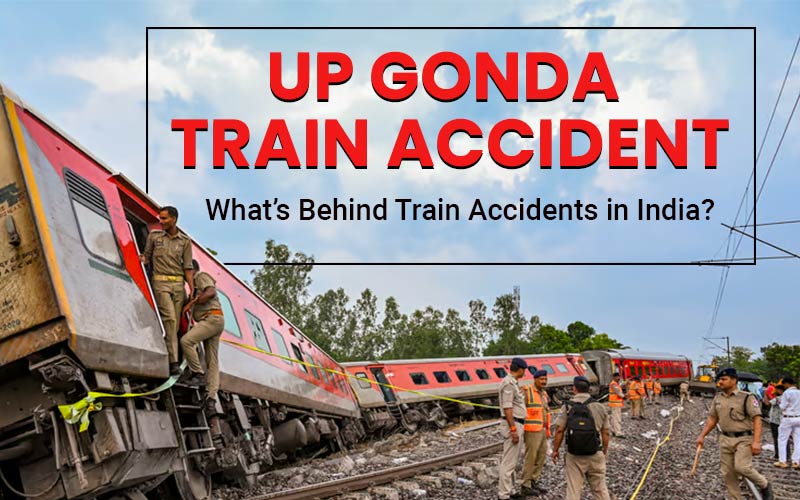
UP Gonda Train Accident: What’s Behind Train Accidents in India?
The Assam-bound
Chandigarh-Dibrugarh Express derailed, leading to the toppling of eight
coaches. The incident took place near Gonda, between Motiganj and Jhilahi
railway stations, about 150 km from Lucknow. Two people lost their lives, and
about 34 were reportedly injured in the accident. Fortunately, no casualties
were reported from Assam. The Chief Ministers of Assam and Uttar Pradesh,
HimantaBiswaSarma and Yogi Adityanath, expressed their shock and sorrow over
the incident on social media. CM Adityanath also announced Rs. 10 lakh
compensation to the bereaved families.
The Ongoing Issue of
Train Accidents
In June 2023, a devastating collision in Odisha involved the Coromandel
Express, SMVT Bengaluru–Howrah SF Express, and a goods train, leading to over
288 deaths and more than 1,000 injuries due to signal failure and human error.
Another tragic incident occurred in June 2024 near Jalpaiguri, West Bengal,
where the Kanchanjunga Express collided with a goods train, resulting in at
least 11 fatalities and numerous injuries, with initial investigations
highlighting crew lapses and operating department issues.
Train accidents have
been a persistent and serious issue in India for a long time. These incidents
can be categorized into various types, including derailments, level crossing
accidents, collisions, and fires. Each type of accident has its own set of
causes and consequences, contributing to the overall safety challenges faced by
the Indian Railways.
Types of Train
Accidents
Derailments: The most
common type of train accident, often caused by track issues, mechanical
failures, or human error.
Level Crossing
Accidents: Occur when trains collide with vehicles or pedestrians at railway
crossings, frequently due to negligence or lack of proper signaling.
Collisions: These
involve trains colliding with each other or with stationary objects, usually
due to signal failures or miscommunication.
Fire Accidents:
Though less common, fires in trains can be devastating, often caused by
electrical faults or the mishandling of inflammable materials.
Statistics of Train
Accidents Over the Years
1971-1972 to
1981-1982: 9,968 accidents
- 1982-1983
to 1992-1993: 7,013 accidents
- 1993-1994
to 2003-2004: 4,620 accidents
- 2004-2005
to 2014-2015: 1,853 accidents
- 2015-2016
to 2021-2022: 449 accidents
Analysis of
Train-Related Deaths (2017-2021)
The Crime Records
Bureau reported over 100,000 train-related deaths from 2017 to 2021. The
primary causes of these accidents were:
- Derailments
(69%)
- Level
Crossing Accidents (32%)
- Collisions
(5%)
- Fire
Accidents (3%)
Root Causes of Train
Accidents
Investigations into
train accidents have identified several root causes. Human error accounts for
85% of total accidents, encompassing mistakes by railway staff such as signal
errors, miscommunication, or improper handling of equipment. Equipment failure,
responsible for 5% of accidents, often results from mechanical failures in
trains or tracks due to inadequate maintenance or outdated infrastructure.
Sabotage, making up 4% of the causes, includes deliberate acts of disruption
sometimes related to terrorism or local disputes. Lastly, climatic conditions,
contributing to 3% of accidents, involve natural factors like heavy rains, fog,
or extreme temperatures that can affect track stability and visibility.
Measures to Combat
Train Accidents
To address these
incidents and improve railway safety, several measures can be taken:
- Renovate
Old Train Infrastructure: The government should prioritize the renovation
of old train infrastructure dating back to the British era. Upgrading
tracks, signals, and rolling stock will significantly reduce the risk of
accidents.
- Proper
Training and Awareness: Railway staff should receive comprehensive
training to enhance their vigilance and ability to handle emergencies.
This includes regular drills and updates on safety protocols.
- Technological
Upgrades: Implementing advanced technologies such as automated signaling
systems, real-time tracking, and predictive maintenance tools can prevent
many accidents caused by human error and equipment failure.
- Improving
Level Crossings: Installing barriers, warning systems, and educating the
public about the dangers at level crossings can reduce accidents at these
critical points.
- Enhanced
Surveillance: Using CCTV cameras and monitoring systems can help detect
and prevent sabotage and other malicious activities.
- Emergency
Response Plans: Establishing robust emergency response plans and ensuring
all railway staff are familiar with them can mitigate the impact of
accidents when they occur.
Learning from Global
Standards
Japanese Railway Model: Renowned for safety, punctuality, and advanced technology. India can
draw lessons from Japan’s rigorous safety standards and technological
innovations to improve its own railway network.
Implementing these measures
is essential for reducing train accidents and ensuring safer journeys for
passengers. Continuous improvements and a focus on safety will help in significantly
reducing train accidents in India.
For India to progress
effectively as a nation, the railway system must undergo significant
improvements to ensure safety, quality, and cleanliness. Given that the
majority of the population relies on railways for long-distance travel,
addressing these issues is crucial.
Disclaimer: The opinions expressed in this article are those of the author's. They do not purport to reflect the opinions or views of The Critical Script or its editor.

Newsletter!!!
Subscribe to our weekly Newsletter and stay tuned.

















Related Comments